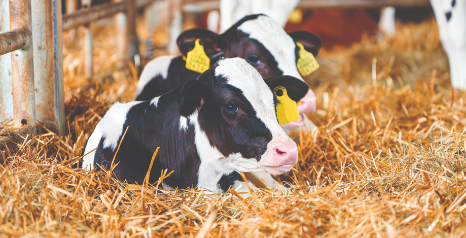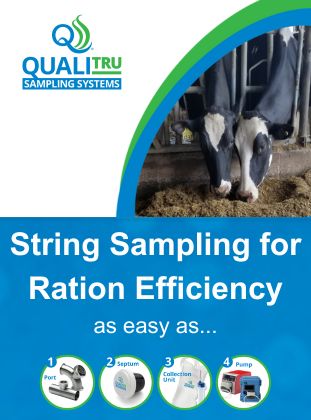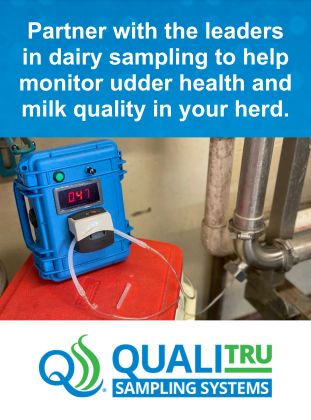Tackling Calf Recumbency in the Holstein Breed

By Jaclyn Krymowski
Mastering and understanding the miniscule details of genetics can take a lifetime of research, experience and education. For this reason dairies work with specialized companies and industry associations armed with resources that help them manage the breeding program. Despite our best efforts, there will be times when a defective or recessive gene is discovered that can disrupt overall breed performance and individual animal welfare. Earlier in 2023, there were several articles released that covered and went over the Holstein genetic defect coined “calf recumbency.” Calf recumbency is also known as Early Onset Muscle Weakness Syndrome (MW) and a major concern across the breed. In a May 2023 document, Holstein Association USA issued a statement: “According to current research, this disorder usually begins within the first two months of life, where calves exhibit muscle weakness, become unthrifty and succumb to secondary health problems, such as pneumonia, or are euthanized. No known treatments are available at this time. There is some confusion about this condition due to inconsistency in describing its severity, reports of eventual recovery and most importantly, the underreporting of deaths. More genotyped heifers with pedigree data and livability records are needed to develop a clearer picture.” While this condition has not yet been recognized as an official disorder by the Holstein Association, it is currently a “Genetic Condition Under Investigation.” The industry is moving swiftly to implement testing and develop a path forward.
Where the issue lies
Based on observations from breeders, the animals impacted by Calf Recumbency were weak and unable to stand at or shortly after birth – however it may not show up until a bit later, typically within the first two months of life.
In most instances the reported calves did not survive beyond six weeks of age. Interestingly, there was no detection of any neurologic, infectious or metabolic abnormalities in these cases, according to Jeff Mulhollem in a research article for Penn State.
The big question is how this surfaced and why it’s a sudden issue, but there is some information tracing back when it was introduced and how it was “hidden” within the breed until recently.
“Researchers traced the nearest ancestor to a common sire born in 2008 that was present for both paternal and maternal lineages of all affected calves,” writes Mulhollem. “That sire had an influential son born in 2010 that is now one of the most highly related bulls to the Holstein breed. Subsequent research has identified a bull born in 1984 as one of the first carriers, and perhaps the progenitor, of the mutation.”
Research by Dr. Chad Dechow conducted at Penn State in 2022 found that the mutation causing the defect is located on chromosome 16.
Dechow and his team were able to identify the haplotype or segment of DNA, and found that all affected calves were homozygous and inherited two copies of the gene – one from each parent.
Impact and management
Dairy producers and Holstein breeders so they can avoid adding or amplifying the defect through their own herd.
If unaddressed by the industry, this defect can become amplified and further spread into the gene pool as more carriers are unintentionally bred, thereby increasing the odds of more homozygous calves.
One management application that has become a great tool for producers is genomics and DNA testing that provides a plethora of information.
In Calf Recumbency cases specifically, collecting DNA samples of affected calves for genotyping along with any family members allows for tracing and identification purposes.
“The identified haplotype is common and traces back many generations, but the number of homozygous calves in the national database is lower than expected,” reports an April 2023 article published by the Council on Dairy Cattle Breeding (CDCB), Recumbency in Holstein Calves.
“This points to a recent mutation within the haplotype, just like Holstein Cholesterol Deficiency (HCD). Recent mutations make tracing a haplotype back to a clear source animal difficult because we deal with a large number of normal haplotypes and a smaller number of mutated haplotypes, but they have the same ‘signature’ of genetic markers.”
CDCB also highlights that the dairy industry as a whole needs to develop more strategies that will allow for practical, continuous monitoring of the breeding cattle population in order to spot emerging defects as well as maintain the collection of high-quality biological samples and phenotypic information.
While making a better system for testing and identification may be a long term goal, now is the time for individual farmers to do their part and report abnormal calves to identify defects accurately and quickly.
Other paths to improvement
Part of reducing the Calf Recumbency defect is to act quickly to identify and make careful mating decisions to avoid further incorporating it.
Beyond the farm, there is ample room for genetic companies to work alongside other industry professionals to develop optimal processes and technologies for future matings.
The sire company Genex, for example, offers GENEX MAP+™ mating program and GENEX DairySuite™ precision genetics program to prevent matings between known Calf Recumbency or MW carriers.
But one of the drawbacks to private companies is that they can only provide so much information individually as each manages their own databases and bulls.
Industry professionals are taking action to assist producers. Most recently, the USDA’s Animal Genetics and Improvement Laboratory (AGIL) and CDCB are working on a more accurate haplotype test.
To best avoid the defect, farmers can test cows genomically for Recumbency and ensure they are only bred to non-carrier bulls. However, this will be a process collecting the data on an industry-wide scale to spot carrier cows and bulls.
Addressing the Recumbency defect in the industry requires swift and efficient action to maintain normal production processes. Providing accurate diagnostic tools is a top priority, despite the challenges associated with identifying its various origins.
Reporting and testing are crucial steps forward. The Holstein Association USA has an Abanormality Report form accessible via their website which they request breeders fill out and submit under suspicion of Recumbency. The association’s Genetic Services department can also be contacted for more information and assistance with genetic testing.
Collaboration between producers and industry professionals is essential, with producers notifying defects or signs and industry experts ensuring their tools and carrier information remain up-to-date. By working together and fostering communication, the industry can effectively tackle this issue.



